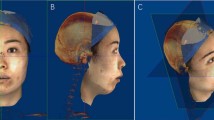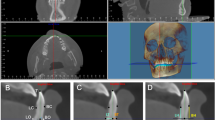Abstract
Background Class III malocclusions with maxillary retrognathia are commonly treated with single jaw Le Fort I maxillary advancement. The three-dimensional (3D) effects of surgery on the nasolabial region varies among the clinical studies. Quantifying these changes is of great importance for surgical planning and obtaining valid consent.
Objectives To investigate the 3D relationship between soft tissue and skeletal changes secondary to Le Fort I maxillary advancement surgery in skeletal class III patients.
Search methods Comprehensive search of multiple electronic databases supplemented by a manual and grey literature search were undertaken from inception to 9 June 2020.
Selection criteria Studies that evaluated the 3D soft tissue changes of patients before and after maxillary advancement surgery alone.
Data collection and analysis Study selection, data extraction and risk of bias assessment were performed independently by two reviewers, with disputes resolved by a third reviewer. A quantitative synthesis of the data was pre-planned for pooling similar outcome measures.
Results Four studies were included in the final review and meta-analysis, with a total of 105 patients (mean age 16.7 + 33.9 years). The mean maxillary advancement of the included studies was 5.58 mm (95% CI 5.20-5.96). The sagittal effects of surgery on nose tip projection and prominence were insignificant (P >0.05, two studies); however, subnasal projection (MD 1.7 mm, two studies) and upper lip projection (MD 2.90 mm, four studies) increased significantly in a forward direction after surgery (P <0.05). Le Fort I osteotomy widens the upper philtrum width (MD 0.84 mm, two studies) (P <0.05). Inconsistencies among the included studies were identified; therefore, the results should be interpreted with caution.
Conclusions There is weak evidence based on quantitative assessments that Le Fort I maxillary advancement significantly affects the nasolabial soft tissue envelope mainly in a sagittal dimension. These changes are concentrated around the central zone of the nasolabial region. Future prospective studies on maxillary advancement osteotomy with a standardised method of assessment, taking into consideration the confounding factors, are required.
This is a preview of subscription content, access via your institution
Access options
Subscribe to this journal
Receive 4 print issues and online access
$259.00 per year
only $64.75 per issue
Buy this article
- Purchase on Springer Link
- Instant access to full article PDF
Prices may be subject to local taxes which are calculated during checkout
Similar content being viewed by others
Change history
24 June 2022
A Correction to this paper has been published: https://doi.org/10.1038/s41432-022-0263-x
References
Proffit W R. Contemporary orthodontics. 5th ed. St Louis: Mosby, 2013.
Khamashta-Ledezma L, Naini F B. Systematic review of changes in maxillary incisor exposure and upper lip position with Le Fort I type osteotomies with or without cinch sutures and/or VY closures. Int J Oral Maxillofac Surg 2014; 43: 46-61.
San Miguel Moragas J, Van Cauteren W, Mommaerts M Y. A systematic review on soft-to-hard tissue ratios in orthognathic surgery part I: maxillary repositioning osteotomy. J Craniomaxillofac Surg 2014; 42: 1341-1351.
Ubaya T, Sherriff A, Ayoub A, Khambay B. Soft tissue morphology of the naso-maxillary complex following surgical correction of maxillary hypoplasia. Int J Oral Maxillofac Surg 2012; 41: 727-732.
Wong K W F, Keeling A, Achal K, Khambay B. Using three-dimensional average facial meshes to determine nasolabial soft tissue deformity in adult UCLP patients. Surgeon 2019; 17: 19-27.
Sarver D M, Johnston M W, Matukas V J. Video imaging for planning and counseling in orthognathic surgery. J Oral Maxillofac Surg 1988; 46: 939-945.
Van Loon B, Van Heerbeek N, Bierenbroodspot F et al. Three-dimensional changes in nose and upper lip volume after orthognathic surgery. Int J Oral Maxillofac Surg 2015; 44: 83-89.
Djordjevic J, Toma A M, Zhurov A I, Richmond S. Three-dimensional quantification of facial symmetry in adolescents using laser surface scanning. Eur J Orthod 2014; 36: 125-132.
Lagravère M O, Low C, Flores-Mir C et al. Intraexaminer and interexaminer reliabilities of landmark identification on digitized lateral cephalograms and formatted 3-dimensional cone-beam computerized tomography images. Am J Orthod Dentofacial Orthop 2010; 137: 598-604.
Almukhtar A, Ju X, Khambay B, McDonald J, Ayoub A. Comparison of the accuracy of voxel based registration and surface based registration for 3D assessment of surgical change following orthognathic surgery. PLoS One 2014; DOI: 10.1371/journal.pone.0093402.
Nada R M, Maal T J, Breuning K H, Berge S J, Mostafa Y A, Kuijpers-Jagtman A M. Accuracy and reproducibility of voxel based superimposition of cone beam computed tomography models on the anterior cranial base and the zygomatic arches. PLoS One 2011; DOI: 10.1371/journal.pone.0016520.
Olate S, Zaror C, Mommaerts M Y. A systematic review of soft-to-hard tissue ratios in orthognathic surgery. Part IV: 3D analysis - Is there evidence? J Craniomaxillofac Surg 2017; 45: 1278-1286.
Shafi M, Ayoub A, Ju X, Khambay B. The accuracy of three-dimensional prediction planning for the surgical correction of facial deformities using Maxilim. Int J Oral Maxillofac Surg 2013; 42: 801-806.
Ullah R. The validity of 3dMD Vultus in predicting soft tissue morphology following orthognathic surgery. Birmingham: University of Birmingham, 2014. Thesis.
Resnick C, Dang R, Glick S, Padwa B. Accuracy of three-dimensional soft tissue prediction for Le Fort I osteotomy using Dolphin 3D software: a pilot study. Int J Oral Maxillofac Surg 2017; 46: 289-295.
Knoops P G M, Borghi A, Breakey R W F et al. Three-dimensional soft tissue prediction in orthognathic surgery: a clinical comparison of Dolphin, ProPlan CMF, and probabilistic finite element modelling. Int J Oral Maxillofac Surg 2019; 48: 511-518.
Paredes de Sousa Gil A, Guijarro-Martínez R, Haas Jr O L, Hernández-Alfaro F. Three-dimensional analysis of nasolabial soft tissue changes after Le Fort I osteotomy: a systematic review of the literature. Int J Oral Maxillofac Surg 2019; 48: 1185-1200.
Shamseer L, Moher D, Clarke M et al. Preferred reporting items for systematic review and meta-analysis protocols (PRISMA-P) 2015: elaboration and explanation. BMJ 2015; DOI: 10.1136/bmj.g7647.
Bernardo W M. PRISMA statement and PROSPERO. Int Braz J Urol 2017; 43: 383-384.
Cumpston M, Li T, Page M J et al. Updated guidance for trusted systematic reviews: a new edition of the Cochrane Handbook for Systematic Reviews of Interventions. Cochrane Database Syst Rev 2019; DOI: 10.1002/14651858.ED000142.
Moher D, Shamseer L, Clarke M et al. Preferred reporting items for systematic review and meta-analysis protocols (PRISMA-P) 2015 statement. Syst Rev 2015; 4: 1.
Lisboa C O, Martins M M, Ruellas A C O, Ferreira D M T P, Maia L C, Mattos C T. Soft tissue assessment before and after mandibular advancement or setback surgery using three-dimensional images: systematic review and meta-analysis. Int J Oral Maxillofac Surg 2018; 47: 1389-1397.
Schmidt L, Shokraneh F, Steinhausen K, Adams C E. Introducing RAPTOR: RevMan Parsing Tool for Reviewers. Syst Rev 2019; 8: 151.
Guyatt G H, Oxman A D, Schunemann H J, Tugwell P, Knottnerus A. GRADE guidelines: a new series of articles in the Journal of Clinical Epidemiology. J Clin Epidemiol 2011; 64: 380-382.
Egger M, Smith G D, Schneider M, Minder C. Bias in meta-analysis detected by a simple, graphical test. BMJ 1997; DOI: 10.1136/bmj.315.7109.629.
DeSesa C R, Metzler P, Sawh-Martinez R, Steinbacher D M. Three-dimensional Nasolabial Morphologic Alterations Following Le Fort I. Plast Reconstr Surg Glob Open 2016; DOI: 10.1097/GOX.0000000000000685.
Metzler P, Geiger E J, Chang C C, Sirisoontorn I, Steinbacher D M. Assessment of three-dimensional nasolabial response to Le Fort I advancement. J Plast Reconstr Aesthet Surg 2014; 67: 756-763.
Nkenke E, Vairaktaris E, Kramer M et al. Three-dimensional analysis of changes of the malar-midfacial region after LeFort I osteotomy and maxillary advancement. Oral Maxillofac Surg 2008; 12: 5-12.
Verdenik M, Ihan Hren N. Three-dimensional facial changes correlated with sagittal jaw movements in patients with class III skeletal deformities. Br J Oral Maxillofac Surg 2017; 55: 517-523.
Schendel S A, Williamson L W. Muscle reorientation following superior repositioning of the maxilla. J Oral Maxillofac Surg 1983; 41: 235-240.
Yamada T, Mishima K, Moritani N et al. Nasolabial morphologic changes after a Le Fort I osteotomy: a three-dimensional anthropometric study. J Craniofac Surg 2010; 21: 1089-1095.
Khamashta-Ledezma L, Naini F B, Manisali M. Review of nasal changes with maxillary orthognathic surgery. J Istanb Univ Fac Dent 2017; DOI: 10.17096/jiufd.09789.
Mitchell C, Oeltjen J, Panthaki Z, Thaller S R. Nasolabial aesthetics. J Craniofac Surg 2007; 18: 756-765.
Sheen J H. Secondary rhinoplasty. Plast Reconstruc Surg 1975; 56: 137-145.
Silva A, Magri L V, Osborne P R, Trivelatto A E, Sverzut C E, Silva M. Three-Dimensional Nasal Alterations in Le Fort I Advancement: Linear Measurements, Angles, Nasal Indices, and Volume Differences. J Craniofac Surg 2019; 30: 1125-1130.
Akan B, Gökçe G, Karadede Ünal B, Sezen Erhamza T. Assessment of soft tissue changes after LeFort I advancement. Eur Arch Otorhinolaryngol 2021; 278: 813-839.
Maal T J J, van Loon B, Plooij J M et al. Registration of 3-Dimensional Facial Photographs for Clinical Use. J Oral Maxillofac Surg 2010; 68: 2391-2401.
Aynechi N, Larson B E, Leon-Salazar V, Beiraghi S. Accuracy and precision of a 3D anthropometric facial analysis with and without landmark labelling before image acquisition. Angle Orthod 2011; 81: 245.
van der Vlis M, Dentino K M, Vervloet B, Padwa B L. Postoperative swelling after orthognathic surgery: a prospective volumetric analysis. J Oral Maxillofac Surg 2014; 72: 2241-2247.
Acknowledgements
The data underlying this article are available in the article and in its online supplementary material. No funding was received for this paper.
Author information
Authors and Affiliations
Contributions
MA, HM, AU and JR designed the study and guided the protocol development. MA, HM and AU supervised this work. MA and SM performed the updated search of literature. JR and AU undertook study selection while MA was involved as a third reviewer in this process. JR and MA performed the data extraction while AU was involved as a third reviewer in this process. SM and MA judged the methodological quality while MW was involved as a third reviewer in this process. SM, AU, MA and MW analysed the data and worked on data interpretation. All authors carried out manuscript writing, refining the manuscript, and read and approved the final manuscript.
Corresponding author
Ethics declarations
The authors declare that there is no conflict of interest.
Rights and permissions
About this article
Cite this article
Almuzian, M., Rowley, J., Mohammed, H. et al. Three-dimensional nasolabial changes after maxillary advancement osteotomy in class III individuals: a systematic review and meta-analysis. Evid Based Dent (2021). https://doi.org/10.1038/s41432-021-0188-9
Published:
DOI: https://doi.org/10.1038/s41432-021-0188-9



